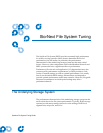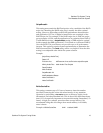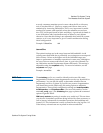
StorNext File System Tuning
The Metadata Controller System
StorNext File System Tuning Guide 8
Some metadata operations such as file creation can be CPU intensive, and
benefit from increased CPU power. The MDC platform is important in
these scenarios because lower clock- speed CPUs such as Sparc and Mips
degrade performance.
Other operations can benefit greatly from increased memory, such as
directory traversal. SNFS provides three config file settings that can be
used to realize performance gains from increased memory:
BufferCacheSize, InodeCacheSize, and ThreadPoolSize.
However, it is critical that the MDC system have enough physical
memory available to ensure that the FSM process doesn’t get swapped
out. Otherwise, severe performance degradation and system instability
can result.
FSM Configuration File
Settings 0
The following FSM configuration file settings are explained in greater
detail in the
cvfs_config man page. For a sample FSM configuration file,
see Sample FSM Configuration File
on page 25.
The examples in the following sections are excerpted from the sample
configuration file from Sample FSM Configuration File
on page 25.
Stripe Groups
0
Splitting apart data, metadata, and journal into separate stripe groups is
usually the most important performance tactic. The
create, remove, and
allocate (e.g., write) operations are very sensitive to I/O latency of the
journal stripe group. Configuring a separate stripe group for journal
greatly benefits the speed of these operations because disk seek latency is
minimized. However, if
create, remove, and allocate performance aren't
critical, it is okay to share a stripe group for both metadata and journal,
but be sure to set the exclusive property on the stripe group so it doesn't
get allocated for data as well. It is recommended that you assign only a
single LUN for each journal or metadata stripe group. Multiple metadata
stripe groups can be utilized to increase metadata I/O throughput
through concurrency. RAID1 mirroring is optimal for metadata and
journal storage. Utilizing the write-back caching feature of the RAID
system (as described previously) is critical to optimizing performance of
the journal and metadata stripe groups.


















